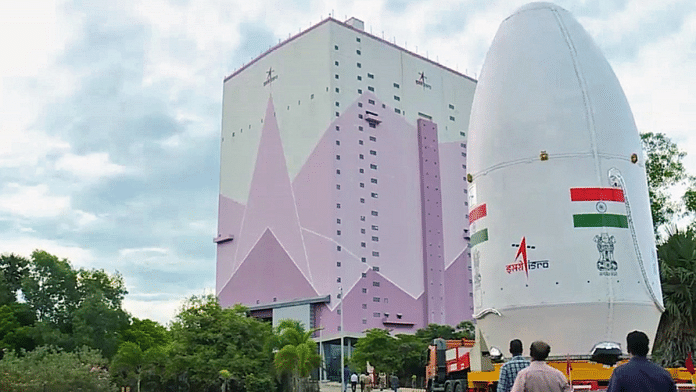Bengaluru: Chandrayaan-3, Indian Space Research Organisation’s (ISRO) third moon mission, will launch on 14 July at 2.35 pm from the Second Launch Pad at Satish Dhawan Space Centre, Sriharikota. The mission is a tech demonstrator aimed to test its landing and roving capabilities, and thus does not carry sophisticated payloads.
Its success will set the ball rolling for the Indo-Japanese Lunar Polar Exploration Mission that is being considered for 2025. The spacecraft is expected to land on the moon on 23 August 2023.
The mission’s lander, Vikram, and rover, Pragyan, have the same names — although with upgraded design — as those of the second lunar mission, Chandrayaan-2. However, there is no orbiter in this mission. Both the lander and rover of Chandrayaan-2 crashed on the moon on 6 September 2019.
Chandrayaan-3 will be launched on the Launch Vehicle Mark-III, or LVM3, which had also launched Chandrayaan-2. The spacecraft will be carried in the exposed nose-cone — the conically shaped front-most section of a rocket — before it pushes itself using its own propellant or fuel towards the moon.
Objectives and design
The prime objective of the mission is to demonstrate the engineering behind the spacecraft — to be able to both land and rove. This is also necessary before the 2025 Indo-Japanese Lunar Polar Exploration Mission, the robotic lunar mission conceptualised by ISRO and Japan Aerospace Exploration Agency (JAXA).
Other than that, the mission has simple payloads for making scientific observations of the soil, and carrying out experiments on the composition as well as with water.
The Vikram lander has been upgraded with stronger legs and more instrumentation redundancy to reduce the chances of loss of signal.
Named after the founder of the Indian space programme, Vikram Sarabhai, the craft weighs 1,471 kg; and with its dimensions being 8 ft 4 in × 6 ft 7 in × 3 ft 11 in, it’s about the size of a small bus.
It is also equipped with a propulsion module that will manoeuver the stack (made up of the propulsion module and the lander module carrying the rover) into a 100 km circular lunar orbit.
The Pragyan rover is the payload and will exit the lander upon safe touchdown, ready to explore the surface. The 3 ft x 2.5 ft x 2.8 ft vehicle weighs 26 kg, has six wheels, and is about the size of a small bedside table. It’s equipped with solar panels for power, carries two cameras for navigation, and will move at the speed of 1 cm/sec.
Both Vikram and Pragyan are expected to function for one lunar day or 14 Earth days, beyond which the lack of sun will cause the mission to lose power and the extreme cold of the lunar night will throttle structure and equipment.
The lander will use its powerful thrusters to come to a stop in the southern hemisphere, closer to the pole.
Also Read: ISRO wants to send civilian scientists, doctors to space to research microgravity
Getting to the moon
The LVM3 will perform orbit-raising manoeuvres by orbiting earth five times and raising the spacecraft higher before it uses its propulsion module to break away into a trajectory to the moon.
While approaching the moon, it will do the opposite, where the propulsion module will help slow down the stack and lower its orbit. It will orbit the moon five times before coming down to a 100 km circular orbit.
The stack will remain here for a period of time that is yet to be announced to test all its systems.
It will attempt to land softly on 23 August, and will use its legs to come to a standing position. If a location is not decided, the mission will wait for the lunar night to be over (14 earth days) and fix a date in September 2023 for landing. The rover ramp will then be deployed to roll out Pragyan.
There is also an umbilical connector between the lander and rover, which is an upgrade from Chandrayaan-2. This keeps the rover connected to the lander physically even when the former moves away.
Payloads
The LVM3’s propulsion module carries a third payload called Spectro-polarimetry of Habitable Planet Earth (SHAPE) to obtain spectral and polarimetric data of earth from lunar orbit.
The Vikram lander consists of the Radio Anatomy of Moon Bound Hypersensitive ionosphere and Atmosphere (RAMBHA) to study the negligible atmosphere on the moon, the Chandra’s Surface Thermophysical Experiment (ChaSTE) to measure the thermal conductivity and temperature, the Instrument for Lunar Seismic Activity (ILSA) for measuring moonquakes around the landing site, and the Langmuir Probe (LP) to calculate the moon’s surface plasma density and its fluctuations over time.
There is a last payload, which is from NASA — a passive Laser Retroreflector Array (LRA) for lunar laser ranging studies, which will measure the distance between the Earth and the moon using lasers fired from earth and reflected back from the moon.
The Pragyan rover carries the Alpha Particle X-ray Spectrometer (APXS) and Laser Induced Breakdown Spectroscope (LIBS) for studying the composition of the soil at the landing site.
(Edited by Uttara Ramaswamy)
Also Read: Successful test flight of SSLV-D2 gives ISRO a new, low-cost rocket



